A noisy car air compressor can be an unsettling experience for any driver, transforming a peaceful cabin into a source of distracting rattles, squeals, or grinding sounds. While some operational noise is normal, particularly upon initial startup, persistent or unusually loud sounds often signal underlying issues requiring attention. Understanding the potential causes is the first step towards diagnosis and resolution.
Common Noise Types and Their Potential Causes:
-
Rattling or Clunking:
-
Loose or Worn Mounts: The car air compressor is secured by rubber-mounted brackets. Over time, these mounts can deteriorate, crack, or loosen, allowing the compressor unit to vibrate excessively against the engine or chassis, creating a distinct rattling or clunking noise, especially at idle or low RPM.
-
Internal Component Failure: Severe internal damage, such as a broken piston, connecting rod, or failed bearings within the compressor itself, can cause loud knocking or rattling sounds. This often indicates significant mechanical failure requiring compressor replacement.
-
-
Squealing or Screeching (Often Belt-Driven):
-
Worn or Loose Serpentine Belt: The most common source of high-pitched squealing related to the AC system. The serpentine belt drives the car air compressor's clutch pulley. A belt that is worn, glazed, loose, or contaminated (e.g., with oil) will slip on the pulley, especially when the compressor clutch engages to turn on the AC. The sound typically changes pitch with engine RPM.
-
Failing Compressor Clutch Bearing: The clutch assembly on the front of the car air compressor has a bearing. When this bearing wears out or seizes, it produces a continuous squealing or grinding noise whenever the engine is running, regardless of whether the AC is on or off. The noise may lessen slightly when the clutch is disengaged.
-
-
Grinding or Growling:
-
Internal Bearing Failure: Bearings inside the compressor that support the rotating shaft can wear out. This typically produces a lower-pitched grinding, rumbling, or growling noise that increases with engine RPM and is most noticeable when the AC is engaged. It signifies internal wear within the car air compressor.
-
Lack of Lubrication (Oil): The car air compressor requires refrigerant oil circulating with the refrigerant for lubrication. If the system has a leak leading to low refrigerant and oil levels, or if the wrong type/amount of oil was used during servicing, internal components can run dry, causing severe grinding noises and rapid compressor failure.
-
-
Whirring or Howling:
-
High System Pressure: Excessively high pressure within the AC system, potentially caused by an overcharge of refrigerant, a blockage (like a clogged expansion valve or receiver-drier), or poor condenser airflow (due to debris or fan failure), can force the compressor to work harder, sometimes producing a whirring or howling sound.
-
Worn Internal Components: Moderate internal wear within the compressor can sometimes manifest as a constant whirring or humming sound that increases with compressor speed.
-
-
Clicking (Rapid On/Off Cycling):
-
Low Refrigerant Charge: While not always "noisy" in the traditional sense, a system low on refrigerant can cause the compressor clutch to cycle on and off rapidly (every few seconds). This frequent engagement and disengagement create a distinct, repetitive clicking sound from the clutch area. Low refrigerant leads to poor cooling and risks compressor damage due to lack of lubrication.
-
Diagnostic Approach and Importance of Professional Help:
Diagnosing the exact cause of a noisy car air compressor requires systematic troubleshooting:
-
Identify When and How the Noise Occurs: Does it happen only when AC is on? Only at startup? At idle? Under acceleration? Is it constant or intermittent? Does engaging/disengaging the AC change it?
-
Locate the Source: Use a mechanic's stethoscope (carefully, away from moving belts) to pinpoint if the noise is coming directly from the compressor body, the clutch, the belt tensioner, or nearby components.
-
Check Belt Condition and Tension: Inspect the serpentine belt for cracks, glazing, fraying, or looseness.
-
Observe Clutch Operation: With the engine running and AC on, visually check if the clutch engages smoothly and stays engaged. Rapid cycling is a key indicator of low charge.
-
Measure System Pressures: This requires specialized AC manifold gauges. Abnormal high or low pressures point towards specific system issues (blockages, leaks, overcharge).
Crucially, working on automotive AC systems involves handling refrigerants under pressure, which requires specialized equipment, knowledge, and certification (e.g., EPA Section 608 in the US). Attempting DIY repairs without proper training and tools can be dangerous, ineffective, illegal regarding refrigerant handling, and may cause further damage.
A noisy car air compressor should never be ignored. While some causes, like a loose belt, might be relatively simple fixes, others, such as internal mechanical failure or severe lubrication issues, indicate significant problems that can lead to complete compressor failure and potential system contamination if debris circulates. Unusual noises are often the first warning sign. Prompt diagnosis by a qualified automotive technician is essential. They can accurately identify the root cause – whether it's the compressor itself, its clutch, the drive belt, or an issue within the AC system affecting compressor operation – and recommend the appropriate repair. Addressing the noise early can prevent more costly repairs down the road and ensure your vehicle's air conditioning system operates effectively and reliably.


 English
English Português
Português عربى
عربى 中文简体
中文简体











